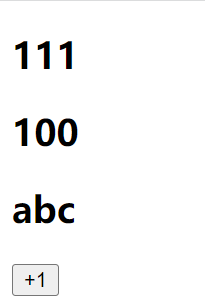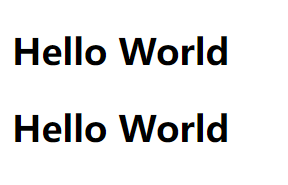4. vue基本指令
4.1 Mustache 语法
Mustache语法(双大括号)的文本插值
- ==data返回的对象==是有添加到==Vue的响应式系统==中;
- 当==data中的数据发生改变==时,==对应的内容也会发生更新==。
- 当然,Mustache中不仅仅可以是data中的属性,也可以是一个==JavaScript的表达式==。
示例:
html
<!DOCTYPE html>
<html lang="en">
<head>
<meta charset="UTF-8">
<meta http-equiv="X-UA-Compatible" content="IE=edge">
<meta name="viewport" content="width=device-width, initial-scale=1.0">
<title>Document</title>
</head>
<body>
<div id="app"></div>
<template id="my-app">
<!-- 1.mustache的基本使用 -->
<h2>{{message}} - {{message}}</h2>
<!-- 2.是一个表达式 -->
<h2>{{counter * 10}}</h2>
<h2>{{ message.split(" ").reverse().join(" ") }}</h2>
<!-- 3.也可以调用函数 -->
<!-- 可以使用computed(计算属性) -->
<h2>{{getReverseMessage()}}</h2>
<!-- 4.三元运算符 -->
<h2>{{ isShow ? "哈哈哈": "" }}</h2>
<button @click="toggle">切换</button>
<!-- 错误用法 -->
<!-- var name = "abc" -> 赋值语句 -->
<!-- <h2>{{var name = "abc"}}</h2>
<h2>{{ if(isShow) { return "哈哈哈" } }}</h2> -->
</template>
<script src="../js/vue.js"></script>
<script>
const App = {
template: '#my-app',
data() {
return {
message: "Hello World",
counter: 100,
isShow: true
}
},
methods: {
getReverseMessage() {
return this.message.split(" ").reverse().join(" ");
},
toggle() {
this.isShow = !this.isShow;
}
}
}
Vue.createApp(App).mount('#app');
</script>
</body>
</html>4.2 v-once指令
- v-once用于指定元素或者组件只渲染一次:
当数据发生变化时,元素或者组件以及其所有的子元素将视为静态内容并且跳过;
该指令可以用于性能优化;
- 如果是子节点,也是只会渲染一次:
示例:

html
<!DOCTYPE html>
<html lang="en">
<head>
<meta charset="UTF-8">
<meta http-equiv="X-UA-Compatible" content="IE=edge">
<meta name="viewport" content="width=device-width, initial-scale=1.0">
<title>Document</title>
</head>
<body>
<div id="app"></div>
<template id="my-app">
<h2>{{counter}}</h2>
<div v-once>
<h2>{{counter}}</h2>
<h2>{{message}}</h2>
</div>
<button @click="increment">+1</button>
</template>
<script src="../js/vue.js"></script>
<script>
const App = {
template: '#my-app',
data() {
return {
counter: 100,
message: "abc"
}
},
methods: {
increment() {
this.counter++;
}
}
}
Vue.createApp(App).mount('#app');
</script>
</body>
</html>4.3 v-text指令
用于更新元素的 textContent:

示例:

html
<!DOCTYPE html>
<html lang="en">
<head>
<meta charset="UTF-8">
<meta http-equiv="X-UA-Compatible" content="IE=edge">
<meta name="viewport" content="width=device-width, initial-scale=1.0">
<title>Document</title>
</head>
<body>
<div id="app"></div>
<template id="my-app">
<h2 v-text="message"></h2>
<h2>{{message}}</h2>
</template>
<script src="../js/vue.js"></script>
<script>
const App = {
template: '#my-app',
data() {
return {
message: "Hello World"
}
}
}
Vue.createApp(App).mount('#app');
</script>
</body>
</html>4.4 v-html指令
- 默认情况下,如果我们展示的内容本身是 html 的,那么vue并不会对其进行特殊的解析。
- 如果我们希望这个内容被Vue可以解析出来,那么可以使用 v-html 来展示;
示例:

html
<!DOCTYPE html>
<html lang="en">
<head>
<meta charset="UTF-8">
<meta http-equiv="X-UA-Compatible" content="IE=edge">
<meta name="viewport" content="width=device-width, initial-scale=1.0">
<title>Document</title>
</head>
<body>
<div id="app"></div>
<template id="my-app">
<div>{{msg}}</div>
<div v-html="msg"></div>
</template>
<script src="../js/vue.js"></script>
<script>
const App = {
template: '#my-app',
data() {
return {
msg: '<span style="color:red; background: blue;">哈哈哈</span>'
}
}
}
Vue.createApp(App).mount('#app');
</script>
</body>
</html>4.5 v-pre指令
- v-pre用于跳过元素和它的子元素的编译过程,显示原始的Mustache标签:
- 跳过不需要编译的节点,加快编译的速度;
示例:
html
<!DOCTYPE html>
<html lang="en">
<head>
<meta charset="UTF-8">
<meta http-equiv="X-UA-Compatible" content="IE=edge">
<meta name="viewport" content="width=device-width, initial-scale=1.0">
<title>Document</title>
</head>
<body>
<div id="app"></div>
<template id="my-app">
<h2 v-pre>{{message}}</h2>
</template>
<script src="../js/vue.js"></script>
<script>
const App = {
template: '#my-app',
data() {
return {
message: "Hello World"
}
}
}
Vue.createApp(App).mount('#app');
</script>
</body>
</html>4.6 v-cloak指令
- 这个指令保持在元素上直到关联组件实例结束编译。
- 和 CSS 规则如 [v-cloak] { display: none } 一起用时,这个指令可以隐藏未编译的 Mustache 标签直到组件实例准备完毕。
- 不会显示,直到编译结束
示例:
html
<!DOCTYPE html>
<html lang="en">
<head>
<meta charset="UTF-8">
<meta http-equiv="X-UA-Compatible" content="IE=edge">
<meta name="viewport" content="width=device-width, initial-scale=1.0">
<title>Document</title>
<style>
[v-cloak] {
display: none;
}
</style>
</head>
<body>
<div id="app"></div>
<template id="my-app">
<h2 v-cloak>{{message}}</h2>
</template>
<script src="../js/vue.js"></script>
<script>
const App = {
template: '#my-app',
data() {
return {
message: "Hello World"
}
}
}
Vue.createApp(App).mount('#app');
</script>
</body>
</html>